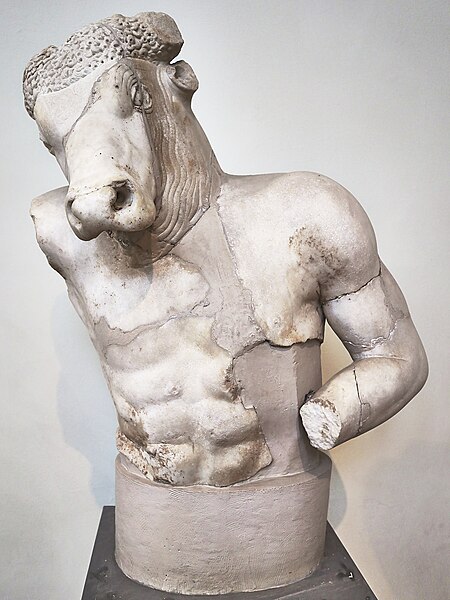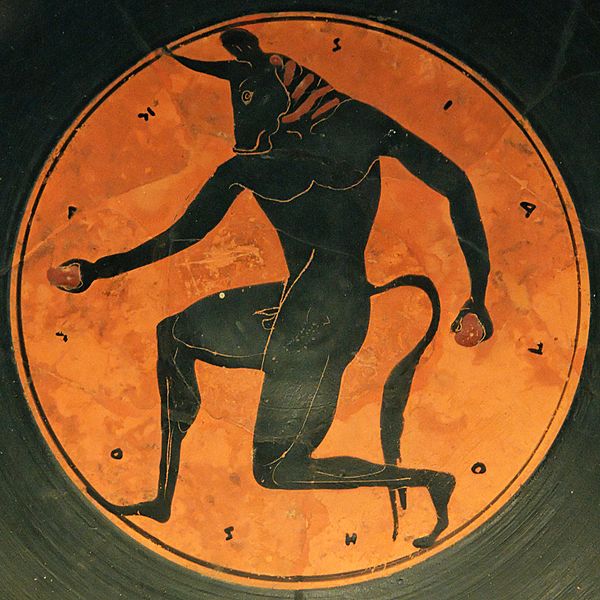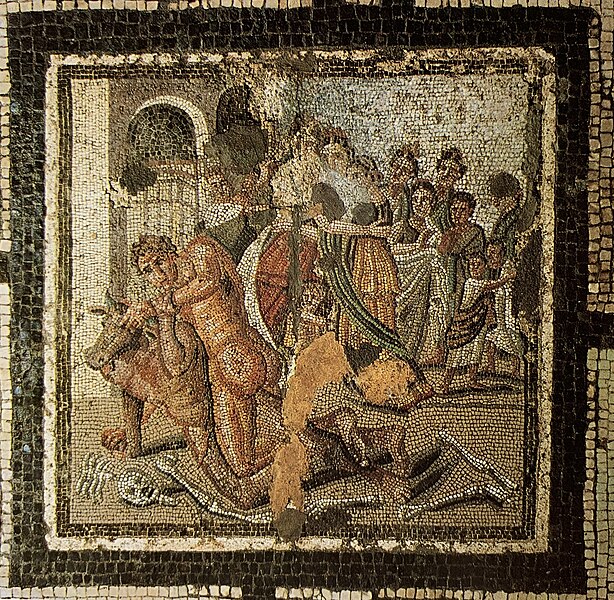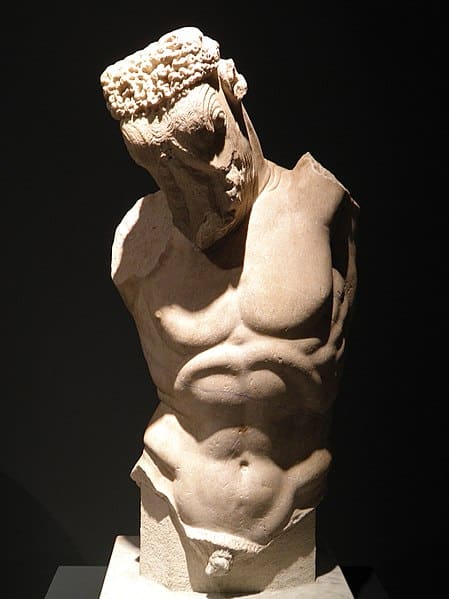The Minotaur, a creature of unparalleled intrigue, stands at the crossroads of man and beast. With the body of a man and the head of a bull, this denizen of the Labyrinth has been a source of fascination and fear for countless generations. As we navigate the winding paths of its tale, let’s uncover the truths and myths that surround this iconic figure of Greek lore.
Minotaur Key Facts
| Keyword | Fact |
|---|---|
| Origin | Labyrinth, Crete |
| Creator | Result of Pasiphaë’s love for the Cretan Bull |
| Defeated by | Theseus |
| Habitat | Labyrinth of Crete |
| Other names | Asterion |
| Roman name | Minotaurus |
| Associated with | Labyrinth, King Minos, Pasiphaë |
| Symbols | Labyrinth, double axe |
Name and Etymology

The Minotaur, often known as “Asterion” in some tales, is a creature whose name itself is a testament to its dual nature. Derived from the Ancient Greek words “Minos” and “Taurus,” which translate to “Minos’ Bull,” the name encapsulates the creature’s connection to King Minos and its bull-like features.
While the Greeks had their interpretation, the Romans, too, were not untouched by the allure of this creature. In their tales, the Minotaur was often referred to as “Minotaurus,” a slight variation but one that carried the same essence and weight of its Greek counterpart.
The name “Asterion,” which means “starry” or “ruler of the stars,” adds another layer of depth to the Minotaur’s identity. It’s a nod to the creature’s royal lineage, being the stepson of King Minos and a reminder of its place in the cosmos of Greek myths.
Minotaur Origin and Creation
The birth of the Minotaur is a tale steeped in passion, deceit, and divine intervention. Pasiphaë, the wife of King Minos, was struck by a potent spell, leading her to fall deeply in love with the Cretan Bull, The Mighty Beast. This unnatural union resulted in the birth of the Minotaur, a creature that was neither man nor bull but a blend of both.
Trapped within the confines of the Labyrinth, a maze designed by the legendary Daedalus, father to Icarus, the Minotaur became a symbol of terror and mystery for the people of Crete. Its existence was not just a testament to the whims of the gods but also a reflection of the complexities of human nature and desire.
The Labyrinth, while a prison for the Minotaur, also became its realm. The intricate pathways and endless turns mirrored the complexities of the creature’s own existence, making it both a captor and a protector.
The Sacrifice to the Minotaur
Every year, as a tribute to the Minotaur, the city of Athens was forced to send seven young men and seven maidens to Crete. These unfortunate souls were thrust into the Labyrinth, left to wander its confusing pathways, only to eventually meet their doom at the hands of the Minotaur.
This ritual, while a grim reminder of the Minotaur’s might, also showcased the creature’s tragic existence. Forever trapped within the Labyrinth, it was bound by its nature and circumstances, a prisoner of its own desires and the whims of the gods.
Depiction And Characteristics

The Minotaur, with its tales of terror and tragedy, has been depicted in myriad ways throughout history.
The Minotaur’s appearance is a blend of man and bull. Its human body, often depicted as muscular and imposing, contrasts starkly with its bull’s head, complete with horns and a fearsome visage. This duality, captured in its form, is a reflection of its complex nature and the tales that surround it.
Symbols often associated with the Minotaur include the Labyrinth, representing its prison and realm, and the double axe, a nod to its connection to King Minos and Crete. These symbols, while varied, all tie back to the creature’s tales and significance in Greek mythology.
Minotaur Nature and Behavior
The Minotaur’s nature is a blend of rage, loneliness, and a yearning for connection. Trapped within the Labyrinth, it was both a ruler and a prisoner, its desires and instincts constantly at odds with its circumstances.
To the people of Crete and Athens, the Minotaur was a symbol of terror, a creature to be feared and appeased. However, a closer look at its tale reveals a creature that was as much a victim as it was a villain, its existence a testament to the complexities of fate and desire.
Minotaur Abilities
The Minotaur’s abilities are a subject of much fascination. Its strength, unmatched by any mortal, made it a formidable foe. Tales speak of its ability to navigate the Labyrinth with ease, using its intricate pathways to hunt and ensnare its victims.
However, its might wasn’t just physical. The Minotaur’s knowledge of the Labyrinth, coupled with its instincts, made it a master of its domain. This combination of strength, cunning, and knowledge made the Minotaur a creature to be both revered and feared.
Minotaur Symbols or Associations
The Minotaur is often associated with various symbols, each carrying its own significance. The Labyrinth, representing its prison and realm, is a constant in most depictions. The double axe, a symbol of King Minos and Crete, is another association that ties the creature to its origins and tales.
These symbols, while varied, all emphasize the Minotaur’s significance in Greek mythology, serving as reminders of its tales and the lessons they impart.
Navigate Minotaur’s Labyrinth Game
Could you survive in Minotaur’s labyrinth? Test your skill and take a break from reading by playing this fun and educational game!
Play our other games!
Myths about Minotaur
The Minotaur, with its tales of terror and tragedy, has been at the center of various myths. As we delve deeper, we’ll explore some of the most iconic tales involving this enigmatic creature.
The Labyrinth – A Masterpiece of Design
The Labyrinth stands as one of the most awe-inspiring constructs in Greek mythology. A testament to the unparalleled genius of its creator, Daedalus. This master craftsman, renowned throughout the ancient world, was commissioned to design a structure that would confound all who entered. With winding paths, deceptive turns, and dead ends, the Labyrinth was not just a maze but a bewildering puzzle. Moreover, it was a challenge that few dared to undertake. Its design was such that once inside, escape seemed nearly impossible, showcasing the pinnacle of Daedalus’ architectural prowess.
The Minotaur’s Tragic Confinement

Yet, beyond its architectural marvel, the Labyrinth bore a deeper, more somber significance. It was the prison of the Minotaur, a creature both feared and pitied. Within the maze’s twisting corridors, the Minotaur was isolated from the world. A prisoner not just of the walls that confined him, but of his own tragic nature. Every stone and pathway of the Labyrinth echoed the creature’s desolation and rage. While the world marveled at Daedalus’ creation, it also served as a constant reminder of the Minotaur’s sorrowful existence. It was forever ensnared in a cage of both stone and fate.
Theseus and the Minotaur
Theseus, a young prince of Athens, took it upon himself to end the tributes his city was forced to pay to King Minos of Crete. Every year, Athens had to send seven young men and seven young women to be sacrificed to the Minotaur. The monstrous creature with the body of a man and the head of a bull. Who resided in the heart of the intricate Labyrinth designed by the famed craftsman, Daedalus.
As Theseus ventured into the Labyrinth, he was not alone in his quest. Ariadne, the beautiful daughter of King Minos, had fallen deeply in love with the Athenian prince. Risking her own position and safety, she provided Theseus with a ball of thread. This he unraveled as he delved deeper into the maze. The thread, often referred to as “Ariadne’s thread,” would become his lifeline. Eventually guiding him back out of the treacherous maze after confronting the Minotaur.
The battle between Theseus and the Minotaur was not just a physical confrontation; it was a clash of two worlds. On one side was Theseus, representing hope, courage, and the human spirit’s ability to overcome adversity. On the other was the Minotaur, a tragic figure who, despite his reputation, was a prisoner of his own existence. Born out of a curse and locked away in the Labyrinth, the Minotaur’s life was one of loneliness and rage.
When Theseus finally faced the beast, their combat was intense and heart-wrenching. With every swing and dodge, the prince’s determination shone through. He was both fueled by his desire to save his people and the love he felt for Ariadne. Finally, with a combination of skill, strength, and Ariadne’s assistance, Theseus triumphed, putting an end to the Minotaur’s sad existence.
Representations Of Minotaur In Art

The Minotaur, with its tales of terror and tragedy, has inspired artists for generations. From intricate sculptures to detailed paintings, the creature has been depicted in various forms. Each capturing a different facet of its legend.
One of the most iconic representations is the painting of Theseus confronting the Minotaur. This piece, with its vivid colors and dramatic composition, captures the tension and drama of the moment. Furthermore showcasing both Theseus’ heroism and the Minotaur’s might.
Another popular depiction is the sculpture of the Minotaur in repose, a reminder of the creature’s tragic nature and the complexities of its existence. These artworks, while varied in form and style, all capture the essence of the Minotaur, showcasing its significance in Greek mythology.
Mentions in Ancient Texts
The Minotaur’s tales have been documented in various ancient texts, each offering a unique perspective on the creature. From detailed accounts of its encounters to mentions of its significance, these texts provide a glimpse into the Minotaur’s place in Greek mythology.
One of the most notable mentions is in the works of Plutarch. He provides a detailed account of Theseus’ encounter with the Minotaur. He writes, “Theseus, with the help of Ariadne, managed to navigate the Labyrinth and slay the beast, bringing an end to its reign of terror.”
Another text, the “Odyssey” by Homer, alludes to the Minotaur’s significance, tying it to the larger narrative of Odysseus, The Cunning Hero Of The Trojan War‘ journey. These mentions, while varied, all emphasize the Minotaur’s importance in the annals of Greek mythology.
Frequently Asked Questions
The Minotaur was born from the union of Pasiphaë and the Cretan Bull, a result of her unnatural love for the creature.
Theseus, with the help of Ariadne’s thread, managed to navigate the Labyrinth, confront the Minotaur, and slay the beast.
The Labyrinth was both the Minotaur’s prison and realm, a maze so intricate that no one could navigate its pathways.
Yes, every year, as a tribute, Athens sent seven young men and seven maidens to Crete. They were then thrust into the Labyrinth as sacrifices to the Minotaur.
Featured Image Credit: Cat Lee Ball, Public domain, via Wikimedia Commons
